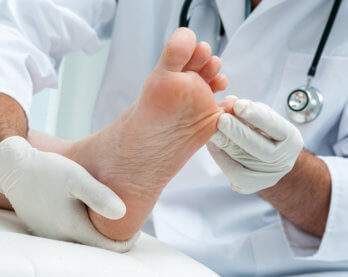We are literally on our feet all day. Throughout the day, we walk, run, jump, or just stand. All this activity can cause us to face some problem or the other related to our feet or ankle. Your orthopedic foot and ankle surgeon will help you to take care of your aching feet and let you go back to your normal life through proper treatment of these 7 conditions
- Achilles Tendinitis/Tendonitis
When the Achilles Tendon gets inflamed, it is called Achilles Tendinitis or Tendonitis. The injury to the tendon can be caused when the muscle gets contracted suddenly and forcefully. This can be Insertional (affecting the lower part of the heel) or Non-Insertional. In the case of the latter, tiny tears in the middle of muscle cause it to break down, thicken and swell. For most people, simply immobilizing the affected foot for some time, followed by physical therapy, is the common course of treatment. But surgery is recommended for young athletes to enable the healed tendon to regain its strength easily.
2. Achilles Rupture
If the Achilles tendon tears partially or totally, it is called Achilles Rupture. This can be due to reduced flow of blood, over-stretching, or any trauma to the muscle. It is commonly seen in active middle-aged people. If not treated properly, a fully torn Achilles tear may not heal and cause difficulty in walking. To help the tendon to heal, a cast, brace or walking boot is used. Surgery can also be done as it helps to improve ankle movement and increases strength.
3. Plantar Fasciitis
When too much pressure is put on the Plantar Fascia, it can get torn or damaged, leading to inflammation. This can affect either the arch or heel or even both. People who have a defective feet structure such as high arched feet or flat feet are quite prone to getting Plantar Fasciitis. Taking rest, applying ice, and stretching the affected area can help. Surgery is done to reduce the tension on the affected muscle.
4. Sesamoiditis
Sesamoiditis refers to the pain in the 2 very small joints under the big toe on the ball of the feet. It is caused when the sesamoid bone and its associated tendon gets inflamed. Usually, pain occurs while performing certain activities. You will need to rest your feet and apply a cold compress or ice to the painful area. Wearing shoes with no or low heels helps. You could tape the big toe so that it bends down a little. If required, you can undergo surgery to remove the affected sesamoids.
5. Bunions
The bump on the big toe is called a bunion. It makes the joint of the big toe move into the second toe, which can result in a change in the bone structure. The condition gradually develops into a painful and visible lump. Wearing wider shoes is suggested to prevent the bunion from growing. If required, surgery can be done to restructure the bones, so bunions don’t reoccur.
6. Hammertoes
When a person wears improper fitting shoes, it can cause a deformity in the joints associated with the toes. It is caused by an imbalance in the muscles surrounding the toes. If diagnosed earlier, wearing proper shoes can help to reverse the condition. However, with time, the deformed bone will get rigid and may require surgery.
7. Osteoarthritis of the foot & ankle
When your foot or ankle joints get inflamed, it could be caused by osteoarthritis. It causes pain or tenderness, swelling, and stiffness in the joint. This is usually caused by wear and tear of the protective cartilage between bones due to old age. The pain and stiffness in joints tend to get to increase as the degeneration progresses. The condition is managed with a combination of medication, braces, and physical therapy. But if these don’t provide relief, surgery helps to reduce pain and have a good quality of life.
ConclusionIf you are overweight or over the age of 50 years, you are more prone to getting problems in the foot and ankle. Wearing comfortable and properly fitting shoes is very important not to exacerbate existing conditions. If you start exercising, walking, or running, it is always advisable to start slowly and gradually increase the amount of time. This allows your body to adjust itself to the activity gradually and not cause injury.

